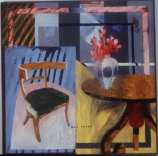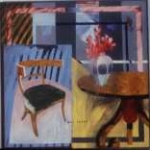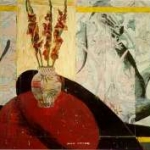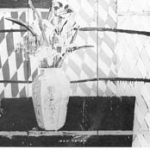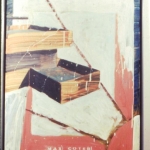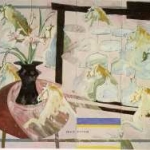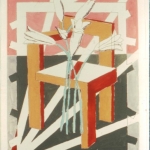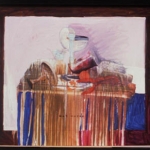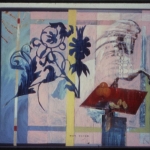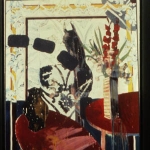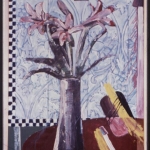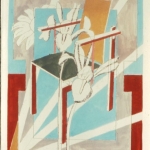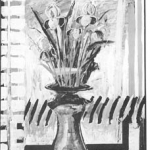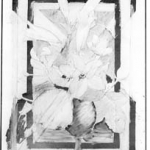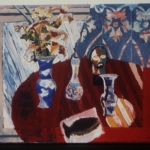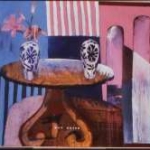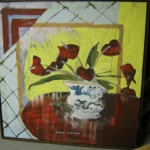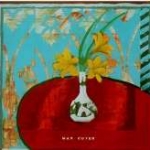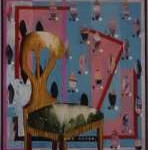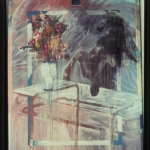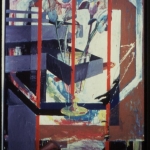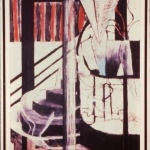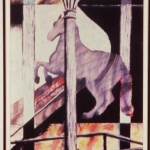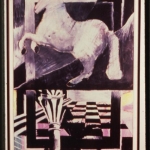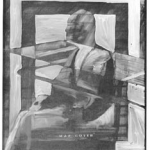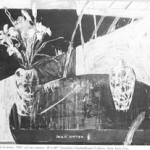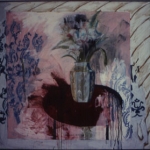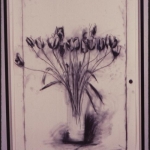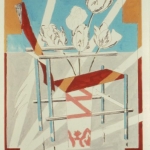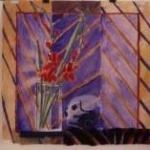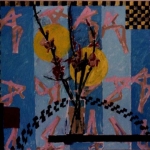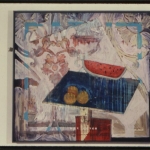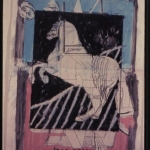Coyer’s last series of work was based upon still lifes of flowers. Coyer had explored other genres; this one is a dangerous subject for a contemporary artist to handle, for it immediately opens him to charges of inconsequentiality and pandering to popular tastes. This is not something new; it has been noted how the academic tradition ranked still life painting as the lowest form of painting, as the artist was “merely” copying what he saw before him. Flowers have also been the traditional subject of the Sunday painter.
Coyer’s floral works, however, are art about art. The subject of the paintings are not flowers painted from life. Instead, the artist has drawn on models from seventeenth century Dutch painters to the American Impressionist Frank Benson. Coyer takes vases and other vessels from those paintings; the flowers themselves were usually drawn from photographs of flowers The paintings are a paeon not to nature but to the artist’s recreation of nature in art.
The works are beautiful, but certainly not in a conventional fashion. Coyer scrapes away, overpaints, and otherwise alters his first strokes. Many of the works have the floral container set atop a round table, whose plane is set on a different perspective than the container’s. In other paintings, the flowers are juxtaposed with Frank Lloyd Wright’s architecture, particularly “Falling Water.” That house was Wright’s most famous attempt to have a building situated harmoniously within its environment. For Coyer, however, the building has always seemed an ambitious failure; the technology of 1936 was insufficient to handle the stresses put on the cantilevers by gravity and the problems of humidity from the stream over which the house rests. The building is not one with nature, but rather one against nature. Coyer uses it in the floral works as an emblem of the artist’s impulse to bend nature to his esthetic impulse. The irony here, of which Coyer is fully aware, is that the “nature” to which Wright’s architecture is here contrasted is not taken directly from life but is rather Coyer’s own interpretation of an earlier interpretation of nature.
-
Alpine Vacation
Year: 1988, Dimensions: 60 x 60, Status: Sold Medium: oil on canvas
-
Annunciation
Year: 1987, Dimensions: 60 x 72, Status: Sold Medium: oil on canvas
-
Bridge
Year: 1987, Dimensions: 48 x 70, Status: Sold Medium: oil on canvas
-
Caliper
Year: 1987, Dimensions: 34 x 26, Status: Available Medium: oil on canvas
-
Cloud Chamber
Year: 1987, Dimensions: 60 x 72, Status: Sold Medium: oil on canvas
-
Day Lilies (Cut Flowers #2)
Year: 1987, Dimensions: 30 x 22, Status: Available Medium: Softground etching with gouache and pencil on Rives BFK paper
-
De Heem Still Life
Year: 1988, Dimensions: 48 x 60, Status: Available Medium: oil on canvas
-
Europe After the Rain
Year: 1988, Dimensions: 60 x 72, Status: Available Medium: oil on canvas
-
Herald
Year: 1987, Dimensions: 84 x 66, Status: Available Medium: oil on canvas
-
Hour of Amaryllis
Year: 1987, Dimensions: 46 x 34, Status: Available Medium: oil on canvas
-
Iris (Cut Flower #3)
Year: 1987, Dimensions: 30 x 22, Status: Available Medium: Softground etching with gouache and pencil on Rives BFK paper
-
Irises
Year: 1987, Dimensions: 60 x 48, Status: Sold Medium: oil on canvas
-
Large Floral Study – for St.Peters, 1986
Year: 1986, Dimensions: 40 x 30, Status: Sold Medium: Oilstick and pastel on paper
-
Last Supper
Year: 1988, Dimensions: 48 x 60, Status: Available Medium: oil on canvas
-
Painting with French Motifs
Year: 1988, Dimensions: 48 x 60, Status: Sold Medium: Acrylic on canvas
-
Pierced Hearts
Year: 1987, Dimensions: 48 x 48, Status: Sold Medium: Oil on canvas
-
Small Pisa
Year: 1988, Dimensions: 39 x 42, Status: Sold Medium: oil on canvas
-
Small Single Chair
Year: 1988, Dimensions: 42 x 39, Status: Available Medium: Acrylic and oil on canvas
-
Square Moon
Year: 1987, Dimensions: 84 x 66, Status: Available Medium: oil on canvas
-
Summer’s End
Year: 1987, Dimensions: 70 x 48, Status: Available Medium: oil on canvas
-
Tassel House Triptych #1
Year: 1987, Dimensions: 70 x 48, Status: Available Medium: oil on canvas
-
Tassel House Triptych #2
Year: 1985, Dimensions: 60 x 30, Status: Available Medium: Oilstick and pastel on museum board
-
Tassel House Triptych #3
Year: 1985, Dimensions: 60 x 30, Status: Available Medium: Oilstick and pastel on museum board
-
The Glass Table – Study for St. Peter’s
Year: 1986, Dimensions: 42 x 34, Status: Sold Medium: oil on canvas
-
The Proud Science
Year: 1987, Dimensions: 48 x 60, Status: Sold Medium: oil on canvas
-
Tiber
Year: 1987, Dimensions: 78 x 84, Status: Sold Medium: oil on canvas
-
Tulips
Year: 1987, Dimensions: 30 x 22, Status: Available Medium: Charcoal and pencil
-
Tulips (Cut Flowers #1)
Year: 1987, Dimensions: 30 x 22, Status: Available Medium: Softground etching with gouache and pencil on Rives BFK paper
- Untitled
-
Untitled Floral
Year: 1988, Dimensions: 39 x 42, Status: Available Medium: oil on canvas
-
Watermelon
Year: 1988, Dimensions: 39 x 42, Status: Sold Medium: oil on canvas
-
White Horse
Year: 1987, Dimensions: 44 x 30, Status: Available Medium: Gouache and oilstick (over Cut Flower, Tulip, proof)

